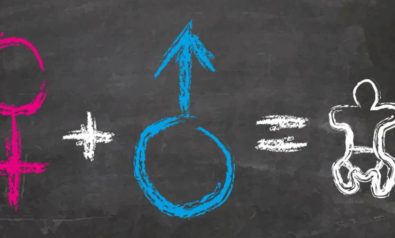To what extent is our sexual behavior determined by evolutionary psychology?
Everyone is familiar with the feeling of utter exasperation with the opposite sex. How common are phrases like “Women, I just don’t get them” or “It’s just another one of those ‘guy things.’” From our ability to park a car, find directions on a map, deal with a crisis situation or maintain a healthy relationship, we often feel that there is a gap between the sexes. The human race has been involved in building bridges across the tumultuous rapids of sexual differences for time immemorial.
Yet there is science behind these societal myths. Notions like free will, rational choice and basic physical attraction are influenced by the nature of our biology, going back to the earliest time of human development. Are men really more likely to cheat? Why is female sexuality more fluid? Can men and women really be friends?
In this interview, Anna Pivovarchuk talks to Professor Barry Kuhle, an evolutionary psychologist, about the science behind our sexual norms.
Anna Pivovarchuk: Laymen’s wisdom tells us that men and women experience sexuality and relationships very differently: what turns them on; what turns them off; how they relate to their sexual partners; how they react to infidelity. What is the science behind these observations? Are men and women really that different when it comes to their sexuality?
Barry Kuhle: A bit. I mean, they’re similar and different. Men and women are equally likely to experience jealousy. One sex is not necessarily more jealous than the other, but there is a sex difference in what’s more likely to trigger jealousy. So males are more likely than women to experience jealousy because they suspect their partner has been sexually unfaithful, whereas women are more likely than men to experience jealousy if they suspect their partner has fallen in love with or formed an emotional connection with somebody else. That said, there are plenty of women who get sexually jealous, plenty of men who get emotionally jealous, but there is a robust sex difference there that has been found across cultures, across time and using various methodologies.
Pivovarchuk: Could you elaborate on that?
Kuhle: The original study was done in 1992 and asked men and women to imagine one of two scenarios: that your partner has had passionate sexual intercourse with somebody else, and then to rate how upset that makes you, and also they did some physiological measures. They measured how much sweating occurs, how much brow furrowing, which we tend to do when we’re upset, and how much their heart rate increased. Males, when they considered and imagined their partner having passionate sexual intercourse with somebody else, rated that as more upsetting than women, and also had higher heart rates, were more likely to furrow their brows and had greater skin conductance, which is a measure of sweating. When women imagined their partners forming a deep emotional attachment with somebody else, all of their indices went up compared to men.
Pivovarchuk: Why is the emotional element of an affair more important to women?
Kuhle: Well, the rationale is twofold. For males, over evolutionary history, they and only they could have been cuckolded by women – that is, duped into raising a child that wasn’t theirs. As the saying goes: it’s mama’s baby, but it’s papa’s maybe. As I tell my students, males have paternity uncertainty, women have maternity certainty. For males, they’re never certain if the child is actually theirs, because women are fertilized internally and you can’t be certain that it was your sperm that got to the egg. Conversely, for women, they can’t be cuckolded, they can’t be duped into raising a child that’s not theirs, but they can lose their partner’s protection, resources and care if their partner falls in love with somebody else. So for women, a greater adaptive problem was not being cuckolded but losing their partner’s time, attention, resources. Hence the sex difference in what triggers jealousy.
Pivovarchuk: So that all goes back to our very first ancestors and the way we functioned in the Stone Age?
Kuhle: That’s the theory behind it. It’s an evolutionary psychological hypothesis, and as I mentioned, this pattern of results has been found across cultures, across time and across various methodologies.
Pivovarchuk: Your research focuses on alloparenting, to explain that women have evolved to have sexual responses to both sexes regardless of their sexual orientation, because of the specific problem of being abused, abandoned or losing their partner. Could you explain how this works?
Kuhle: So this is a paper I published with a grad student at Ryerson University named Sarah Radtke. And at the moment it’s just a hypothesis. We came up with a potential explanation for why women appear to be more sexually fluid than men. Being sexually fluid, as you allude to, does not necessarily imply bisexuality, but over the course of women’s lifespan they appear to be more flexible in the gender they’re looking for in a potential romantic partner than men. Not at any given time, but women tend to be more likely than men to change their labels. So they might identify as heterosexual at one point, bisexual at another point, lesbian at another point and sometimes unlabeled at all. Whereas males are likely to be either heterosexual or homosexual.
So why are women so sexually fluid? Sarah and I put forward the alloparenting hypothesis, in that it’s possible women might be more open than men to, say, other members of the same sex as a means of acquiring alloparenting. Alloparenting, as you know, is when you acquire help for your children aside from genetic relatives, so people who are not related to you. And it’s possible, given that men are more likely to defect from relationships by cheating, more likely to die earlier, more likely to pick up other mates, which would dilute the amount of time, energy, investment they have for you, that women might try to essentially get additional parenting help from other women, and it’s possible that sexual relationships might facilitate that. We outlined, I believe, 14 separate predictions that could falsify or support that hypothesis.
Pivovarchuk: Like what, for instance?
Kuhle: Well, you’d expect women who are divorced and with children would be more likely than women who are currently married with children to be open to romantic and sexual relationships with other women. We even have one, as you alluded to earlier, predicting that women who were sexually abused early on might be more likely later in life to pursue other women as a means of parenting help.
Pivovarchuk: Women whose husbands divested in them for the sake of other women, women whose husbands deserted them, women who have been raped, women who were abused – those are the five main points. So it all goes back to men letting them down in some way.
Kuhle: That’s a good way to put it.
Pivovarchuk: Going back to infidelity, there’s Chris Rock’s joke that a man is only as faithful as his options. Is that true for both men and women?
Kuhle: Both men and women of course commit infidelity. But our best evidence suggests that men are much more likely to cheat than women. And if you look, for example, at men who have a lot more options, particularly those men who have lots of resources, who have a good deal of status, who are older and more attractive — we see this in Hollywood, of course. We see men who are married to or at least in a relationship with some of the most beautiful women in the world. The classic example was Hugh Grant, from about 10, 15 years ago, when he was with Liz Hurley but decided to step out of that relationship and to have, I believe, oral sex with a sex worker, a prostitute somewhere in Hollywood. And in some respects, this surprised people. In other respects it didn’t. Men are much more likely to pursue low-cost sexual opportunities outside of their relationships than women are, and they’re less likely to get attached to those women outside of their relationship than women might be.
Pivovarchuk: You cited a classic study in which 75% of men and 0% of women consented to requests for sex from a complete stranger of the opposite sex. Why is there such a drastic difference?
Kuhle: I love that you mention that. We talk about this study in most of my classes. This was done by Russell Clark and Elaine Hatfield in the early 1980s. As you mention, they did a fascinating study where they hired confederates, people who worked for them who were moderately attractive, to approach members of the opposite sex on a college campus. They were of similar age and went up to members of the opposite sex and asked one of three questions: Would you go on a date with me? Would you come back to my apartment? Would you have sex with me?
Men and women were equally likely to commit to a date from a complete stranger they’ve met for about four seconds who’s moderately attractive. That alone surprised me. The sex difference emerged after that. Women were much less likely than men to consent to go back to the apartment. I believe something like 69% of men but only 6% of women consented to go back to the apartment. When it comes to the “go to bed” question, 75% of men said yes, 0% of women said yes. And that 75% is likely to be an underestimate. Some of those men — and I’ve talked to Elaine about this — asked for rain checks, as in “My girlfriend’s in town, are you free next weekend,” or “My parents are in town.” Some of those men were surely homosexual. So if Clark and Hatfield had solely approached heterosexual, single men, it’s likely that the 75% number would be even higher.
Pivovarchuk: Why is that?
Kuhle: The rationale is over evolutionary history, men – much more so than women – could have increased their reproductive success by increasing the number of sexual partners they had. As I say quite simply to my students, if a female has sex with 100 different guys on 100 different days, she’s still only likely to bear one child. If a male has sex with 100 different women over 100 different days, it’s likely he’s able to have far more children than one. So over evolutionary history, males who pursued these low-cost sexual opportunities, who had an increased desire for sexual variety, would likely have out-reproduced males who didn’t. Whereas for females, additional partners doesn’t buy you much in terms of reproductive currencies. So males have been selected to be much more interested in sexual variety.
And that’s one of the most robust sex differences ever found in the social sciences – a huge effect size. If you ask men and women how many partners would you like to have over various intervals, a month, a year, five years, a lifetime – when you get to a lifetime, males are upwards of 25, 30 in terms of how many partners they report they would like. Women are between five and ten. So women typically don’t want nearly as many sexual partners as men on the average on the whole.
Pivovarchuk: You’ve looped us in to the way sexually-experienced women are perceived by men in our society, finding that the ones who have had many sexual partners are suited for short-term gain, I think that’s the term? So they’re okay to date for a little while, but you wouldn’t marry them.
Kuhle: Absolutely, and I think a lot of women know this. So when you start dating someone, if you have sex with them early on, males are more likely to look at you as a short-term sexual partner, as opposed to a long-term mating partner. In large part because if a woman is likely to have sex with you quite easily early on without knowing much about you, that suggests she might be able to do so with strangers once you are in a relationship. It’s a potential harbinger of cuckoldry. So why settle down with her and increase the specter of infidelity and being cuckolded?
I should mention one thing, women who partake in sexual variety – they receive a bit of derogation from others. They’re not esteemed nearly as much as males are, of course. So there’s tons of terms we use for women who are promiscuous. “Slut,” “whore,” what have you. There’s very few for males; in fact, we oftentimes just throw the word man in front of it, like “man-whore” or “man-slut.” So there’s a lot more condemnation for women for sexual variety. What isn’t grasped as much is that a good deal of that condemnation comes from women. It’s other women who typically slut shame. Males who are looking for short-term mating, they don’t slut-shame. They love that! But short-term mating women are a threat to women interested in long-term mating. Because if you’re interested in a long-term mate, but a woman who’s simply flashing some tits and ass is easily able to acquire your mate, even if for the short term, that’s a threat to your strategic long-term interests.
And it’s not just our society. Most societies that have been studied suggest that women get a lot more heat for being sexually promiscuous than males, and they get it from both sexes, particularly from women. And you can observe this pretty easily. I’ve seen this in large classrooms. So, before class starts, it’s kind of fun to keep an eye on students when they don’t think I’m paying attention, and let’s say a female will walk in with a bit more of a revealing outfit. And the males will look at that female with interest, and the females will look at the other female with contempt. And they’ll even talk to each other: “Who does she think she is?”
Pivovarchuk: What fascinates me is how far back it goes, that those moral codes and behavior patterns have not evolved, even though society’s quite different now, thousands of years later.
Kuhle: That’s a great point. We talk about that in class as well. We have a Stone Age mind in a modern-day world. So the nature of the mechanisms of our mind haven’t changed very much, although the society we’re in has changed in part. But it shouldn’t be that surprising – our society is so much different now with regard to food. We have refined sugar, we have all different types of carbohydrates that we didn’t have before, or at least with regard to the output of the carbohydrates, but our preferences are still very similar to what they were for sweet foods, fatty foods, salty foods. Back in the day that would have been beneficial. Now, not so much, because a cheesecake has more than enough calories to feed a family of four for two weeks back in the day! And now we can demolish it in one sitting. But that Stone Age mind perseveres in a modern-day context. It just gets different inputs into the mechanisms now, which sometimes leads to different outputs. But the mechanisms are the same.
Pivovarchuk: Do you think we’ll ever evolve past it? If we do, how long do you think it’ll take?
Kuhle: I don’t know, but none of us are going to be here, so I don’t really think about that too much. But my students always like to ask that question. And it’s a fascinating question, but it’s not one amenable to science. If the adaptive problems changed, then we would expect the adaptive solutions, the adaptations, the mental mechanisms of the mind to change. But we’re talking hundreds or thousands of generations. We’re also presuming we haven’t wiped ourselves out by that time. Some 99% of all species that have ever existed no longer exist, and we’re going to be one of them at some point. So I don’t know if there’s enough time left for humanity for substantive change to occur. But who knows?
Pivovarchuk: An optimistic prognosis! To take us back to the idea of sexually “promiscuous” norms: Are parents more controlling of girls’ behavior than boys’? I am talking about “daughter-guarding”: Some 40% of parents will tell their daughters to wait for sex until marriage, compared to only 25% for boys. In today’s world, it was quite shocking for me to see that, because we’re all about gender equality, individual freedom. Do children actually follow those instructions? Because the math doesn’t really add up: If 75% of boys are told go out and do whatever they want, who do they do it with?
Kuhle: That’s a great question. There are a couple things to unpack what you mentioned. Carin Perilloux, Diana Fleischman and David Buss, a couple of years ago, put forward the daughter-guarding hypothesis, which as you mentioned is the idea that parents have been designed to protect their daughters’ sexuality more so than their sons’ by encouraging them to wait until marriage, for example, to have sex. And this is something my undergraduate research assistants and I conducted a study on and just published, looking at sex differences in those “birds and bees” talks. So what is it that parents tell their sons and what is it that parents tell their daughters about sex?
And as you alluded to, the evidence suggests that parents are more likely to attempt to restrict their daughters’ sexualities more so than their sons’. They’re more likely to give daughters curfews, they’re more likely to say you can’t be home alone with a non-genetic male in the house, more likely to say “Wait until marriage,” more likely to say “Don’t get a bad reputation.” Whereas men are more likely to hear things like “Have fun! Go out and sow your oats.”
Your question’s a good one, though: How effective are these tactics? Yes, parents appear to be more likely to tell their daughters some things relative to their sons, but we don’t have any evidence so far about how likely children are to follow those rules. And that’s an open question for the future.
We did ask children, “How do you feel about those talks?” We gave them a slew of adjectives, and by far and away the biggest winner was “awkward.” They found those birds and bees talks extraordinarily awkward.
Some, of course, I think erroneously, would argue that having these talks is tantamount to encouraging people to have sex. Which is pretty phenomenal, because people really don’t need encouragement to have sex … Sex has always existed in every species that is sexually reproducing. If anything, I think the talks could stymie it. But there’s a large fraction of the US, mostly conservative religious fundamentalists, who argue that talking about sex, seeing depictions of it, even getting access to birth control, is giving license to having sex and encouraging it. I think there’s very little theoretical support for that, certainly very questionable empirical support for that.
Pivovarchuk: I agree with you. The more you prohibit something, the more powerful its allure. But going back to the way men and women are different: Are men and women drawn to different things in potential partners? Do they look for different things?
Kuhle: Yes. In fact, the study that really put evolutionary psychology on the map was done by David Buss in the late 1980s, where he looked at 37 different cultures located on six different continents with over 10,000 subjects. And he asked them: “What sorts of things would you look for in a mate?” And he gave them, I believe, 18 different characteristics and had them rate it on a 0-3 scale — 0 being irrelevant, 3 being incredibly important. And he found rather robust sex differences.
For example, males are more likely to say that it’s important to them that a female is younger than them. Males are more likely to value physical attractiveness. Women are much more likely to value resources and status and protection and want a guy who’s a bit older. And when he initially conducted this study, he asked prominent sociologists, psychologists and anthropologists of the time, and just about every one of them said: “You will not find these sex differences to be universal. They’ll be culturally variant.” He of course argued, from an evolutionary perspective, we should find this to be rather a pan-human characteristic. And his data suggests it very much was. There were rather robust sex differences across cultures. These cultures vary in tremendous ways in political systems, in mating systems, etc, and yet the sex differences persist.
Pivovarchuk: What about the whole idea of “opposites attract”? Is that a more common scenario in couples, or which one is more likely to last?
Kuhle: That’s kind of a misnomer. In the overwhelming majority of characteristics it’s similarities that attract each other. We tend to be drawn to people of similar race, of similar religion, of similar values, of similar wealth, of similar attractiveness. There’s only two things we’re drawn to “opposite” people: Heterosexuals are drawn to people of the opposite sex, and most people are drawn to people with a slightly different smell to them, which is indicative of what we call an MHC complex – the Major Histo-Comaptatibility Complex. Essentially, it’s a measure of what sorts of things you’re immune to. And it appears that both men and women are drawn to people with a different set of genes, the idea being they’ll be complementary. So your brood of children will have a range of immunities such that any pathogen or parasite wouldn’t wipe out all of your children, some of them would be able to thrive. So the overwhelming majority of things we’re drawn to are similarities, not so much opposites.
Pivovarchuk: There’s a study that looked at how women pick their partners depending on what stage of the menstrual cycle they are in. What was really interesting is that around the time when they’re ovulating they go for the more “manly,” strong types, and then when they stop ovulating they pick the nice, stable guy. I think that’s a very interesting way of looking at the choices that we make, which appear to be conditioned by our physiology and evolutionary history.
Kuhle: These are some tremendous findings. There’s been this ovulation revolution in evolutionary psychology and psychology in general in the last 15 years, showing, as you mention, that women who are not on birth control, who are cycling naturally, their preferences differ as a function of their menstrual cycle phase. The rationale being, women essentially have this duplicitous mating strategy. They’re going to marry this dad-type figure, the type of figure they’re drawn to when they’re not ovulating, who typically have lower testosterone, who are more likely to be investors and protectors. And while they are ovulating they’re drawn to that high-testosterone guy, who’s more likely to be interested in short-term sexual opportunities, so they can get the good genes from the high-testosterone guy and then dupe the father guy, the husband who’s more fatherly, into raising that child. Rather interesting stuff.
Pivovarchuk: That brings us back full circle to the cuckold theory, and the fear: That there’s scientific evidence behind that, which is quite remarkable. What about the famous quote from When Harry Met Sally, that “Men and women can’t be friends because the sex part always gets in the way.” Is that true?
Kuhle: There’s a lot of evidence to suggest it. April Bleske-Rechek pioneered some of this research back in the day, and she has found that in opposite-sex friendships, males are much more likely to value physical attractiveness in an opposite-sex friend than women, and men are more likely to dissolve a relationship when they find that their partner is not interested in them — particularly when they’re interested in somebody else. Males are more likely to look at opposite-sex friends as a potential short-term mating opportunity. Whereas women are more likely to look at an opposite-sex friend as a source of protection. Both men and women do look at OSFs (opposite-sex friendships) as potential long-term mates. Men look at it as more potential for short-term mating than women.
So they can be friends, but the sexuality part does get in the way much more so than people expect. When you ask women this, they tend to say no, but then when you ask women, “Well, does your friend want to have sex with you,” they say yes. So what they’re saying is, “I’m not interested – the sex isn’t getting away for me,” yet they still acknowledge that “No, he wants to have sex with me, I just refuse to acknowledge it.” And in some respects I wouldn’t be surprised if women play into that. That is, they – if not string males along, they at least dangle the opportunity for sex even though they won’t actually commit to it – as a way of keeping that relationship going longer.
Pivovarchuk: I guess since we are on the subject of differences again, to round up: Are men really from Mars and women from Venus, or is there hope in all of this?
Kuhle: I mean that’s overstating it a bit. In most things men and women are quite similar, in the overwhelming majority of characteristics. But when we get to the human mating realm, we see that there’s much more differences than we see in the food realm or the habitat-selection realm. The way I look at it is, men and women largely have similar psychologies, except in human mating realm where we say many large sex differences. Both men and women pursue short-term mating, both men and women pursue long-term mating. But short-term mating looms larger in men’s mating repertoire than it does in women’s. And that’s a pretty robust finding.
We bring you perspectives from around the world. Help us to inform and educate. Your donation is tax-deductible. Join over 400 people to become a donor or you could choose to be a sponsor.
The views expressed in this article are the author’s own and do not necessarily reflect Fair Observer’s editorial policy.
Photo Credit: Panosgeorgiou / Conrado / Rudall30 / Kotin / Shutterstock.com / Tine Hemeryck / Pratik Sanghvi / Flickr
Support Fair Observer
We rely on your support for our independence, diversity and quality.
For more than 10 years, Fair Observer has been free, fair and independent. No billionaire owns us, no advertisers control us. We are a reader-supported nonprofit. Unlike many other publications, we keep our content free for readers regardless of where they live or whether they can afford to pay. We have no paywalls and no ads.
In the post-truth era of fake news, echo chambers and filter bubbles, we publish a plurality of perspectives from around the world. Anyone can publish with us, but everyone goes through a rigorous editorial process. So, you get fact-checked, well-reasoned content instead of noise.
We publish 2,500+ voices from 90+ countries. We also conduct education and training programs
on subjects ranging from digital media and journalism to writing and critical thinking. This
doesn’t come cheap. Servers, editors, trainers and web developers cost
money.
Please consider supporting us on a regular basis as a recurring donor or a
sustaining member.
Will you support FO’s journalism?
We rely on your support for our independence, diversity and quality.






















Comment